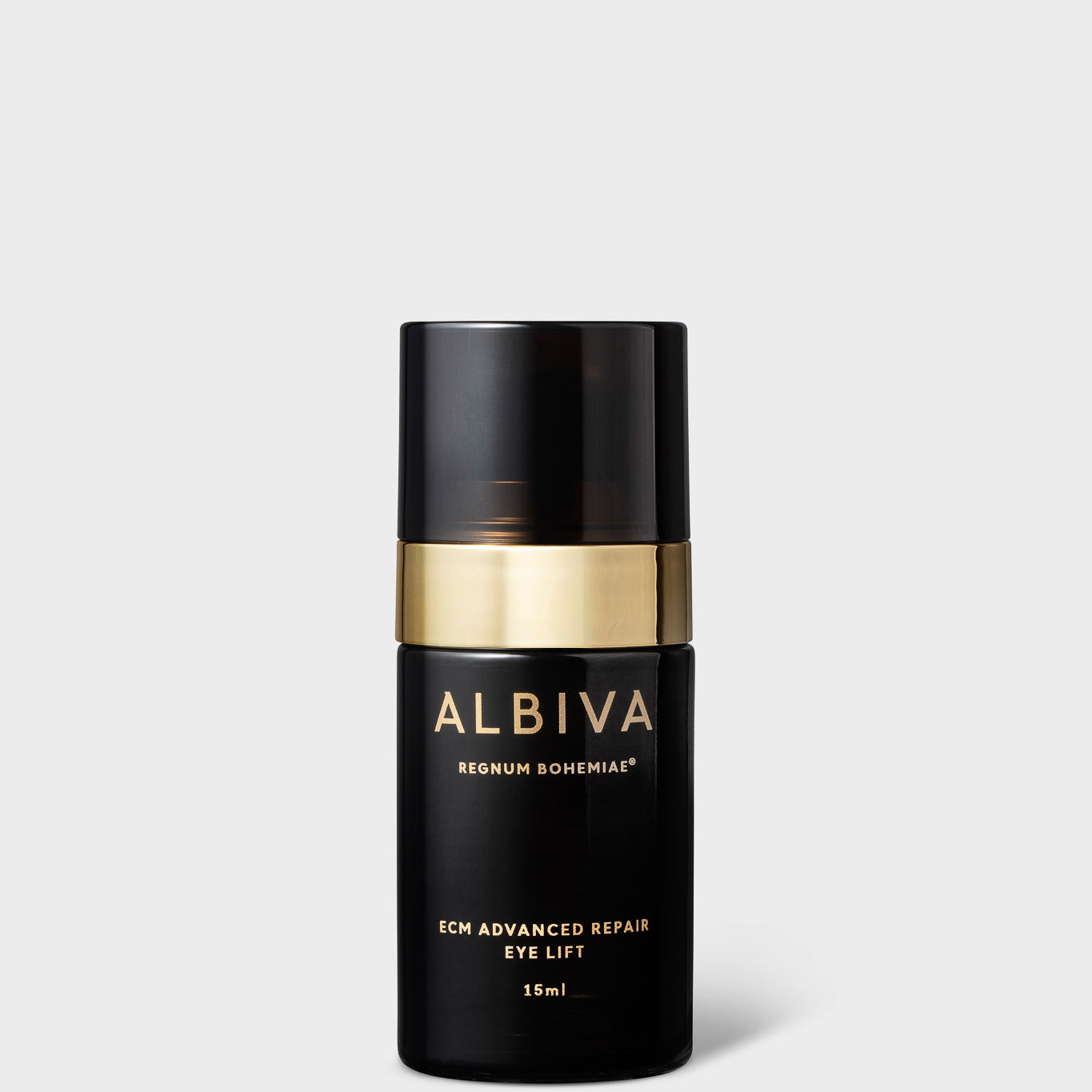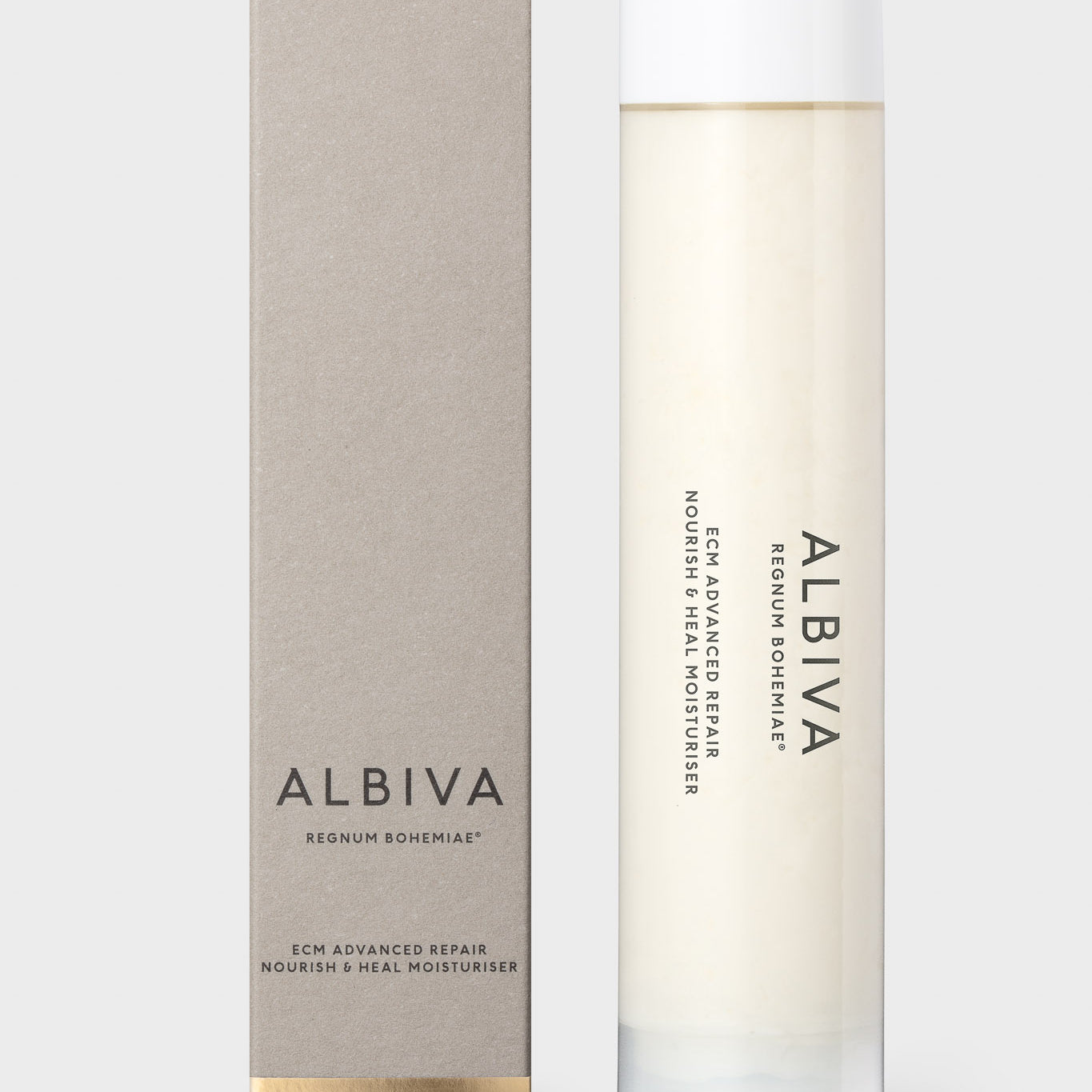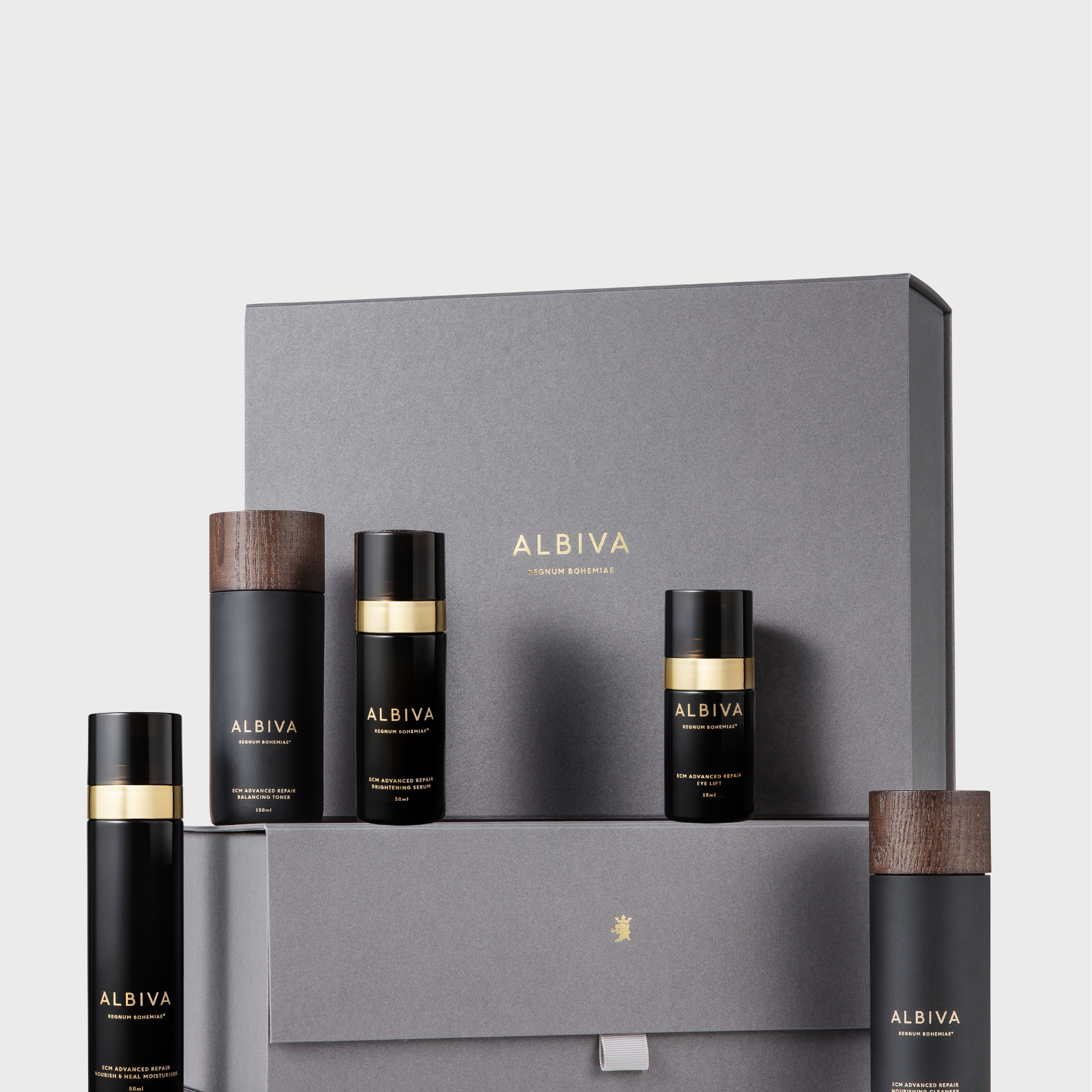HOW TO HAVE A MORE SUSTAINABLE BEAUTY ROUTINE AND OUR THOUGHTS ON SUSTAINABILITY.

Being natural or plastic free tells us very little about a product's sustainability. Similarly, recyclable doesn't equal sustainable.
Many nowadays refer to a product being "green", but what does it mean? It probably refers to sustainability. However, sustainability is a very complex topic and unfortunately a lot of times we like to simplify it down to things that feel right and choose not to focus on the rest.
As we celebrate 'Plastic Free July' this month, we wanted to share what sustainability means to us at ALBIVA. To us it means responsibility. It is our responsibility as a business to consider the product's full lifecycle, to evaluate our products environmental, social, ethical and economical impact. All whilst encouraging you, our customers to reduce your consumption and waste. To us "green" or sustainable means responsible and less impactful. Our ECM Advanced Repair range supports healthy skin as a result of fewer, more effective products, not more. Our desire to put together a capsule collection for a luxe skincare routine was driven by performance, quality and waste reduction.
So what is the easiest way for you to have a more sustainable beauty routine? Buy better, buy less, use less and waste less. Miss-information is not empowering. If you want to do better, start by knowing better and look past the packaging or plastic-free claims. We hope some of the below challenges and question we get asked will help on our sustainability education journey.
What has been the most unexpected challenge in finding sustainable packaging?
The realisation that recyclable doesn’t equal sustainable. Sustainability impacts every aspect of a package—from the source of its raw materials to its end of life—and as such has proven to be an incredibly complex issue.
Knowing our supply chain and have the transparency on where our packaging materials come from was important to make sure we are using responsibly sourced packaging materials.
Also, sometimes a packaging design starts off eco-friendly, but additions like polymer tie straps, cellophane viewing panes, and foil inserts will make them unsustainable again. The greater its mix of materials, the less recyclable it is.
Unfortunately, making the first best impression is crucial in the case of product packaging to attract customers. The moment a product reaches a retail shelf, it becomes vital for it to catch the eye of the customer. Product packaging plays a prime factor in shaping the perception of a customer. It is for this reason, when choosing our packaging three years ago, we found most of the beauty industry packaging to be using film lamination – a thin layer of plastic on top of the paper. It is used to make our packaging ‘glossy’ (it also gives the packaging durability and protection from dirt).
Mostly, paper can’t be recycled if it’s mixed with other materials. Even if some recycling centres have machinery that separate the plastic lining from the paper, this process is resources intensive (electricity, water usage, emissions), increasing the negative impact it has on the environment.
When it comes to the contamination of materials, at the beginning of 2018, China, the main global buyer of recycled paper products, stopped accepting any paper bales with a 1% contamination rate or higher. According to our research, the best recycling facilities are operating at a 4-5% contamination rate.
We wanted to simplify our supply chain as much as possible, and we wanted our packaging to be free from plastic coating and other contaminants, such as glue. We have therefore taken the decision to buy a hand made, raw and 100% biodegradable paper from G.F. Smith (UK company) and manufacture the boxes ourselves. To further reduce resources and our carbon footprint, after the paper is cut, our boxes are folded by hand. The construction of our boxes and the product completion (placing product into the box) is all done under one roof, positively impacting our carbon footprint.
Is all of the packaging sustainable or have some elements been harder to make?
We have started the company with the opportunity and passion to do things differently – especially when it came to sustainability and product design. We looked for smarter design and more sustainable material choices, wanting to reduce our use of plastic as much as possible.
For our first product range, we have chosen to invest in PEFC (sustainable forestry) certified wooden packaging sourced from Europe. Wood is the most sustainable and environmentally favourable material known to man. The production and processing of wood is more energy efficient than most alternatives, giving wooden products a very low carbon footprint. It’s eco-friendly due to its absorption of carbon dioxide while growing, adaptability as a product and recyclability.
However, due to the complex nature of our formulations, and light and air sensitive ingredients (such as vitamins, peptides, etc) we needed to use airless dispensers, which only come in plastic. We have, nevertheless, managed to source airless containers utilising latest airless ‘MEGA’ technology. The new technology eliminates back flow problem‚ which happens when air flows back to the bottle after pumping. Unlike with traditional jars‚ airless technology provides a no cross-contamination solution. The airless bottle has no dip tube, but rather a diaphragm that rises to evacuate the product. When user depresses the pump‚ it creates a vacuum effect‚ drawing the product upwards. Consumers can use almost all of the products without any waste left. There are no metal parts‚ which means our airless bottles are made from only one material and therefore fully recyclable.
We also use plastic bottles for our toner and cleanser.
Plastics have been demonised but sometimes they are the more sustainable option. For example, aluminium and glass, are more carbon intensive to produce than plastic. Glass is also heavier to ship, contributing to higher CO2 emissions. Not every waste management facility recycles it, and for those that do, breakage on route to the facility can mean that the packaging can no longer be recycled.
Are there any challenges in sourcing and manufacturing with sustainable ingredients?
One of the main challenges in sourcing sustainable ingredients is making sure we integrate not only the environmental, but also the social and ethical factors when selecting our suppliers.
Being aware of issues such as natural resource depletion and environmental degradation, we’d like to give couple of examples of sustainable ingredients we buy:
- Cylindrotheca Fusiformis Extract (oceanic marine algae)
Because of the risk of pollution in the sea‚ the producer grows the micro algae in a purpose built eco facility located in Italy. This not only guarantees purity of the algae but also means that the eco balance of the oceans are not disturbed by uncontrolled harvesting. The algae give off gases that are harvested to heat the facility and it is powered by solar panels to give a low carbon footprint.
- Gemmotherapy bud extract of Safflower (Carthamus Tinctorius)
When isolating plant cultures‚ we encounter problems dealing with environmental aggressors such as soil contaminants that alter plant metabolism‚ water pollution‚ air pollution etc. To isolate the most effective active ingredients that are pollution free‚ our producer uses a special facility (so called eco-pods) to cultivate plants under controlled environment. Light‚ air‚ temperature‚ nutrients are auto-controlled. In this protected ecosystem‚ it is possible to harvest buds that are pesticide free‚ fresh and rich in nutrients.
An example of our ingredient selection based on ethical factors:
- Evodia Rutaecarpa Fruit Extract (Wu Zhu Yu)
The fruit is grown in a very specific area of China. The ethical policy of the manufacturer confirms that no slave labour or child labour is used and there is no gender discrimination‚ which is great news for women's rights in China
An example of our ingredient selection based on societal factors:
- 7 Swiss alpine plant extract (Organic) - Mallow‚ Peppermint‚ Cowslip‚ Lady’s Mantle‚ Speedwell‚ Melissa and Yarrow
By being part of this cooperative of farmers in the Alpine region, allows the individual farmers to remain within their respective villages, bring their children up there and make a living.
We also look at the environmental impact of our ingredients in terms of reducing waste and product lifecycle, example:
- Perilla Ocymoides Seed Oil (Organic)
The oil is obtained by cold pressing the seed of the Perilla plant. Perilla seeds yield 35-45% oil. Once pressed the remaining seed cake is used as animal or bird feed.
- Rubus Idaeus (Raspberry) fruit water (Organic)
Our products are formulated with raspberry water (instead of plain water). We utilise the whole raspberry fruit so that there is no waste. Raspberry seeds constitute 10% of the weight of a raspberry and are a major by-product. We use raspberry seed oil during our signature Albiva facial treatments facilitating the massage. We use powdered raspberry seeds for exfoliation during the treatments.
During our manufacturing stage, we use Cold Processing Technology. High heat during standard production process degrades many precious active ingredients such as vitamins‚ peptides‚ oils and antioxidants. Our active ingredients are added to the formulations using cold processing technology to ensure all ingredients retain maximum effectiveness.
Why natural doesn't equal sustainable and what role biotechnology plays in your products?
Ingredients grown in an eco-friendly facilities utilising biotechnology can drastically lower environmental impact, be free of contaminants, have better consistency and perform better. Examples of the technologies used within our products are bio-fermentation, bio-enzymatic processing, cold processing, encapsulation to ingredients grown in a photo bio-reactors.
How have you overcome the challenges to be a sustainable brand?
Some of the most important sustainability challenges for us (and certainly for any business) include eco-friendly packaging, green formulations, transparency and traceability, water management, social impacts and giving back to community.
Sustainability is at the core of our company, fully part of our business’s strategic direction and embedded in our Code of Conduct. We are talking a long-term view and have invested heavily in packaging, ingredients and technology. For us, environmental, social and business objectives are not mutually exclusive.
We have therefore, we believe, overcome the challenges to be a sustainable brand by placing sustainability at the core of what we do (rather than a bolt-on), taking a longer term approach, having clearly defined sustainable strategy and vision and operating our business with integrity and not sacrificing for a short-term gain.
What’s next? Are there any new ethical or eco challenges you want to take on?
Yes, absolutely. We have started formulating our current range and chosen our packaging over 3 years ago now. The technology, materials available and ingredients have seen a lot of innovation in this short amount of space. For us being sustainable is a continuous process of improvement.
We have pledged GBP1 from the sale of every product to charity.
We are certified by Positive Luxury and accredited with their butterfly mark. Their sustainability panel responsible for assessing brands is very thorough and what we like is that they work with brands to improve the areas where they may be lacking. We have rolled out carbon offsets on our website, and we are matching 100% any customer choosing offset their purchase.
Are you able to quantify how much the brand has garnered public interest because it is sustainable?
We believe social, environmental and business objectives are not mutually exclusive.
We believe companies that have environmentally focused strategies are making genuine connections with customers, which translates into success with traditional business measures. Being sustainable is no longer a cost of doing business; it is a catalyst for innovation, new market opportunity, and wealth creation. Consequently, sustainability is no longer just ‘nice to have’ but it is now an expectation, not a differentiator.





